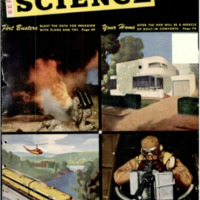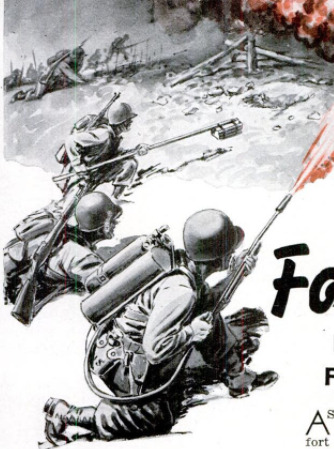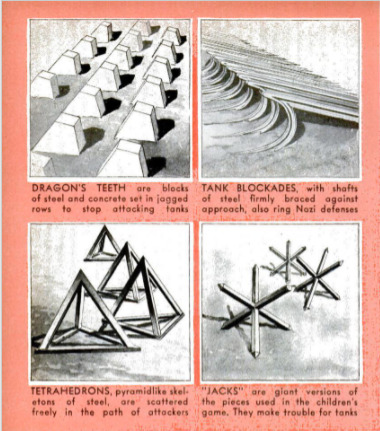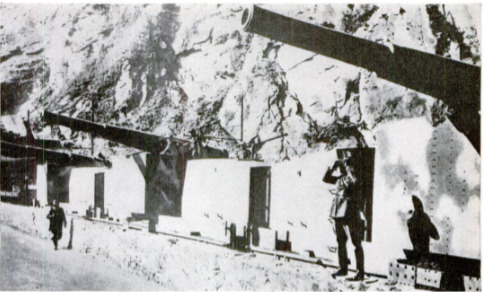-
Title (Dublin Core)
-
Allied weapons to break German defenses
-
Article Title and/or Image Caption (Dublin Core)
-
How fort busters blast a path for invasion
-
extracted text (Extract Text)
-
AS THE spearhead of invasion rips into
the enemy's coastal defense line, the
fort busters have their day. For these
newest, boldest Army specialists must smash
the greatest of all military obstacles—the
shell-belching strongholds of cold steel and
concrete that guard city approaches and
stud countrysides in deadly, defiant patterns
of defense. To reach their objectives, these
demolition wizards of the combat engineers
worm their way under enemy fire, slashing
through barbed-wire entanglements, blast-
ing tank traps, and ridding their path of
treacherous, concealed land mines. Their
chief equipment: TNT, flame throwers, and
courage.
When the fort busters begin to move, you
can be sure the enemy is in for a bad time.
Their “go” sign is a combined assault in
which the region is
pummeled by heavy artillery and aerial
bombardment. This has a triple purpose:
to neutralize enemy fire, to strip the forti-
fications of camouflage, and to open in the
terrain places of concealment for the attack-
ers. Experience has proved
that well-built bunkers,
pillboxes, and blockhouses
can withstand a terrific
pounding. So actual dam-
age is likely to be small,
Soon ‘this aero-artillery
prelude clears the way for
use of the direct-fire guns,
the 155s, the 105's, the
three-inchers, the 75's, and
the 37's. As the demolition
squad slithers forward,
these mobile fieldpieces
open up and begin slam-
ming steel and explosives
at the embrasures, Bunker
crews must close steel
doors to prevent serious
damage. This reduces ene-
my machine-gun fire to a
minimum, and the engi-
neers increase their pace,
now and again leaping up
from their belly crawl and
running a few yards.
It's a strange task force.
Uniforms are nowhere in
evidence. Camouflaged
coveralls speckle the
ground. Weapons are
chosen for the particular
job in hand. On the backs
of several men are the big cylindrical tanks
of flame throwers. Others carry six-foot
sections of pipe loaded with TNT. Used
singly or screwed together to a length of
as much as 200 feet, these become the
famous bangalore torpedoes, so devastating
to wire entanglements. A few men carry
grappling hooks to explode booby traps and
antipersonnel mines by the simple expedient
of tossing them ahead and pulling them back
to catch trip wires. Of utmost importance
are the soldiers with charges of TNT slung
around their necks in satchels, carried in
steel containers, or on long poles for shoving
into bunker portholes. Most of the men lug
hand grenades and one or two have smoke
grenades. Only a handful carry rifles, but
close by, protecting the advance, assault
infantry bangs away with Garands,
In the vanguard at the outset are soldiers
with grappling hooks. They clear the way
for safe passage across the fields. When the
crew reaches the inevitable ring of wire
entanglements, the bangalore boys take over
and make short work of that obstacle with a
deafening blast. The explosion also destroys
antitank mines within three feet of either
side.
Thus the first real break-through occurs,
and now the attackers are covered even
more closely by high-velocity guns, includ-
ing those mounted on tanks, that roll up to
within 1,000 yards of the target. At this
juncture, the’ heavy artillery to the rear
raises its lobbing fire to enemy emplace-
ments beyond those under attack.
Direct fire screams over the heads of the
advancing fort busters, who now are ap-
proaching their objective, The men with the
70-pound flame-thrower tanks on their
backs, copper nozzles in hands, edge into
the lead. Their movements are agile, despite
their load. They know the tricks of their
trade. When they run and fall, they land in
a rolling movement that eases the tanks to
the ground. Otherwise they might break
their backs. They roll over to a crouch be-
fore rising.
In the home stretch, all the men crawl
forward til the target looms only a stone's
throw ahead. Here the leader (a corporal
commands each detachment) lets fly with a
signal rocket. There's a final burst of direct
fire, in the last salvo of which is a smoke
shell, indicating the shift of the bombard- |
ment to adjoining bunkers. Now is the time
for demolition. Into action go the bazookas,
those weird tossers of ultrahigh explosives,
Their projectiles smash at the embrasures
in ear-rending blasts. At 20 yards, the flame |
throwers begin spouting long, roaring jets
of burning oil and gas that blanket the
‘bunker in a mass of fire.
The instant the flame throwers zip off, in |
rush the blasters with TNT. They explode
charges at the bunker doors with a delayed-
action fuse that barely gives them time to
run back a few paces and throw them-
selves to the ground. Timing is geared to a
split second. No sooner does one charge go
off than another
is slapped in place. The job is incomplete
until the walls (sometimes six feet thick)
are opened sufficiently to knock out the
bunker crew with hand grenades. That
done, the leader motions his men on to the
next bunker, leaving the mopping up to as-
sault infantry close behind.
German fixed fortifications are known to
have as many as nine bunkers connected by
bombproof tunnels. Usually each bunker
supports at least two others with its fire,
and the steel-and-concrete network remains
a hazard to attacking forces until the last
fort is smashed. That's the task of the
demolition engineers. They must keep on
smacking as long as there's as much as a
pillbox in the vicinity.
‘The colossal size of the work before them
must be understood by Americans at home
as well as by our military leaders abroad.
It is best shown by intelligence reports that
reveal Germany to have fixed fortifications
running to a depth of 50 miles, concentrated
into jagged belts each several miles deep.
Greatest of all Reich fortifications, the West
Wall (Siegfried Line) has three such belts,
staggered six to 25 miles apart. In the rear
are forts with high-velocity guns usable
against aircraft or ground forces.
Before the first belt is a landscape sown
for 300 yards with mines and gouged with
moats. Then come what our engineers call
“dragon's teeth,” concrete-and-steel tank
obstacles five feet high set in jagged rows
two to six deep. The approaches are topped
with additional mines beneath a tangled
morass of barbed wire. Hitler applies 15,000
mines and 100 tons of wire to each division
front of 5,000 yards.
Blasting the dragon's teeth with TNT is a
relatively simple job once the protecting
bunkers and blockhouses have been demol-
ished. But while these are hurling shrapnel
at the attackers, it's extremely perilous.
Some strategists recommend the use of
smoke screens to blot the enemy’s vision
during assault. Smoke mortars do the trick
easily, but the smoke may work to the dis-
advantage of the attacking force if it be-
comes necessary to see the objective in order
to plaster embrasures with high-velocity
shells.
The West Wall, as tough as it may be to
crack, holds a secondary place in European
fortification lines that must be smashed be-
fore invasion forces attain their goal. The
Nazis have built an almost incredible num-
ber of forts to bolster defense walls and
strongholds on the Channel coast, where the
Dieppe raid showed painfully stiff resistance.
Farther to the south, German engineers are
known to be working feverishly to throw up
and gouge out land blockades of ingenious
types. - And the northern exposure hasn't
been neglected. Just how strong the Nazis
have built their Northwest Wall along the
coast of Norway is not known. But it’s be-
lieved to match any of the Reich's fortifica-
tions, as is the belt of forts erected during
the last year or so on Germany's eastern
border and the Baltic coast.
Nazi engineers sidestep errors in construc-
tion that doomed Belgium's Eben Emael,
France's Maginot Line, and the so-called in-
destructible forts of the Balkans and Greece.
For instance, it is known that most of their
forts may be evacuated easily, or may dis-
gorge men and guns for mobile counterat-
tacks. In the event of devastating frontal
attack, they can shift reinforcements quick-
ly from forts in the rear or to the side.
‘When the Germans reduced “impregnable”
Eben Emael in seven hours with a handful
of combat engineers and TNT, they set the
pattern of destruction that soon may be used
against them. For their enemies have im-
proved the method to a point approaching
perfection. For instance, one of the most
effective weapons of the fort busters is an
improved TNT charge. It's encased in steel,
the same as the one which the Germans be-
gan using for the first time in 1940. But
secret gadgets have greatly increased its
blasting power.
‘The real pay-off, though, is the fact that
the idea originally was as American as
Brooklyn Bridge. In fact, it was a New
Yorker, Prof. Charles E. Munroe, of Colum-
bia University, who conceived it. He wrote
about it in POPULAR SCIENCE MONTHLY in
the year 1900. Eleven years later the Ger-
mans tried to tie up the idea with a patent,
but somehow failed to do so. As an ex-
plosives expert, Professor Munroe discov-
ered that a hollow charge of dynamite was
many times more effective than a solid charge
of the same weight. He experimented by
simply draping a bunch of dynamite sticks
around a can with open end out. Using
nine pounds of dynamite, he blew a hole
three inches in diameter through the five-
inch steel walls of a safe. The charge the fort
busters use weighs 10 pounds and can blow
a hole two inches in diameter through 30
inches of steel-reinforced concrete. It's ex-
ploded by pulling a pin like that used in a
hand grenade.
-
Contributor (Dublin Core)
-
Jack O'Brine (Article Writer)
-
B. G. Seielstad (Illustrator)
-
Language (Dublin Core)
-
eng
-
Date Issued (Dublin Core)
-
1943-09
-
pages (Bibliographic Ontology)
-
49-53,202,204
-
Rights (Dublin Core)
-
Public Domain (Google Digitized)
-
Archived by (Dublin Core)
-
Matteo Ridolfi
-
Marco Bortolami (editor)
 Popular Science Monthly, v. 143, n. 3, 1943
Popular Science Monthly, v. 143, n. 3, 1943






